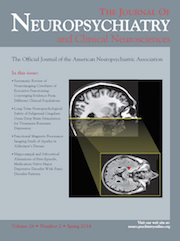First Manic Episode Due to Discontinuation of Valproic Acid in a Patient With Epilepsy
To the Editor: Valproic acid (VA) is one of the most widely used antiepileptic drugs (AED), which is effective for the treatment of both focal and generalized seizures. It is also used extensively to treat multiple nonepileptic disorders such as migraine, neuropathic pain, and some psychiatric diseases. Bipolar disorder is one of the psychiatric diseases for which VA is used commonly as a mood stabilizer. Its use during pregnancy is limited due to high teratogenic risks. At the same time, however, discontinuation of the mood stabilizer during pregnancy carries a high risk for a new episode in women with bipolar disorder.1
Case Report
We hereby present a 25-year-old woman with epilepsy having her first manic episode after discontinuation of VA for conception. She was being followed from our neurology outpatient clinic, and she was on antiepileptic treatment for 5 years for secondary generalized seizures. Her seizures were under control for the last 3 years with levetiracetam 2,000 mg/day and VA 1,500 mg/day treatment. Neither she nor any members of her family had a history of psychiatric illness. For conception, because of the high teratogenic risks of VA, it was gradually decreased and discontinued within 2 months and levetiracetam was continued at the same dose. There was no seizure recurrence after the discontinuation of VA 3 months later. One month later, her husband noticed that her amount of speech and libido increased, and she had started to spend too much money and put on excessive make-up. Her sleep time decreased, and she started to dress with more stylish and expensive clothes. She was more cheerful, fervent, and waggish. She was interested in other guys and was admitted to our psychiatry clinic after she had left her home and husband.
Physical and neurological examinations were normal. At the psychiatric examination, she was cooperative and orientated to time, place, and person. Her amount of speech increased, and her mood was elevated. She was easily getting nervous, distractible, and agitated. She had erotomanic and grandiose delusions. Blood chemistry, electroencephalography, and cranial MRI were normal. Screening tests for narcotics and central nervous system stimulants were negative. She was diagnosed as a first manic episode with psychotic features, and haloperidol 20 mg/day and biperiden 4 mg/day treatments were given and VA 800 mg/day was restarted parenterally. Two weeks, later her symptoms were substantially under control.
Discussion
The most common treatment strategy is using the appropriate AED for seizure control as monotherapy in the lowest effective dosage throughout pregnancy.2 VA acid poses a higher risk compared with other AEDs and should be avoided when possible. The adverse effects of VA on the fetus can present as fetal loss, intrauterine growth retardation, congenital malformations such as cardiac pathologies, neural tube defects, cleft palate and cleft lip, impaired postnatal development, and behavioral problems.3 The most plausible mechanisms of action proposed to explain the beneficial effects of VA in bipolar disorders seems to be its effect on intracellular inositol and protein kinase C activity.4 It is stated that there is a high association between epilepsy and bipolar disorder,5 and although it cannot be proven at this time, our patient could have had a manic episode before if she had not been taking VA, which is effective for both diseases. Although there is a known risk of reappearance or increase of seizures, we present this case to point to the emergence of a first manic episode before or during pregnancy or any other time when the dose of VA is decreased or discontinued, and this condition should be kept in mind even if there is no previous history of a bipolar disorder.
1 : Risk of recurrence in women with bipolar disorder during pregnancy: prospective study of mood stabilizer discontinuation. Am J Psychiatry 2007; 164:1817–1824, quiz 1923Crossref, Medline, Google Scholar
2 : Management of epilepsy during pregnancy. Drugs 2007; 67:2727–2746Crossref, Medline, Google Scholar
3 : Teratogenic effects of antiepileptic drugs. Lancet Neurol 2012; 11:803–813Crossref, Medline, Google Scholar
4 : Antiepileptic drugs in non-epilepsy disorders: relations between mechanisms of action and clinical efficacy. CNS Drugs 2008; 22:27–47Crossref, Medline, Google Scholar
5 : Epilepsy and bipolar disorders. Expert Rev Neurother 2010; 10:13–23Crossref, Medline, Google Scholar



